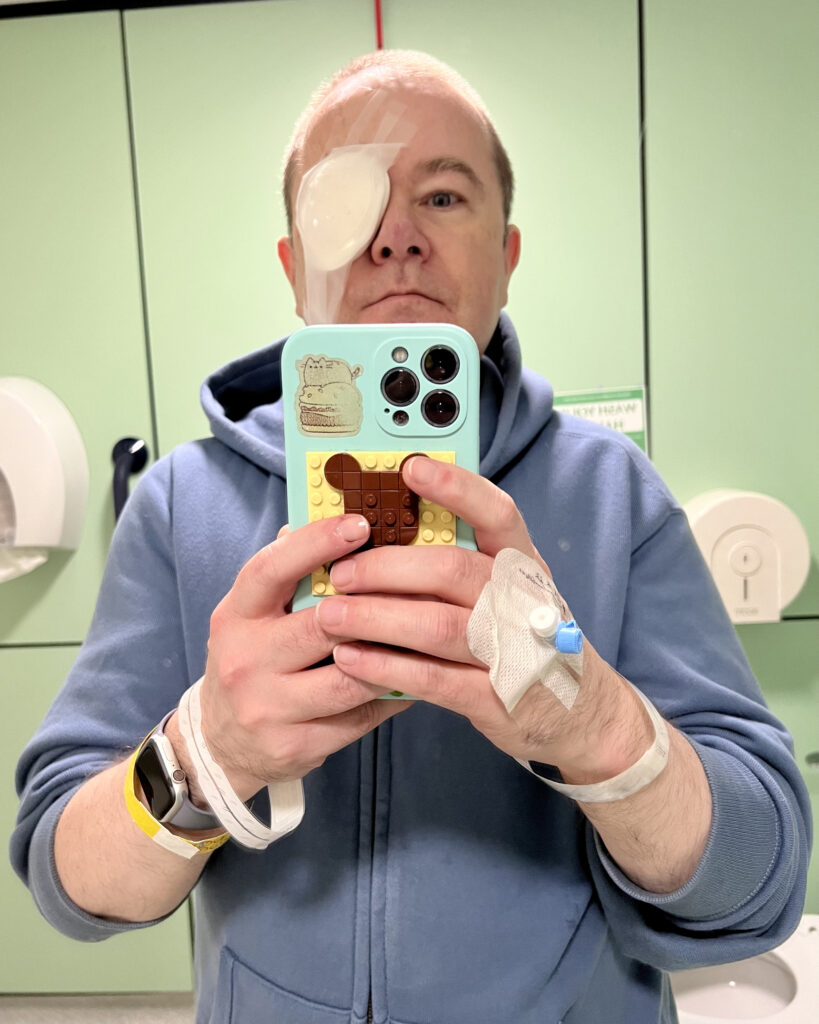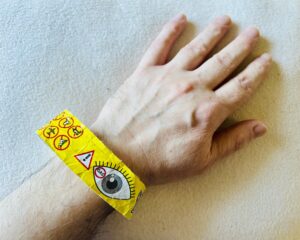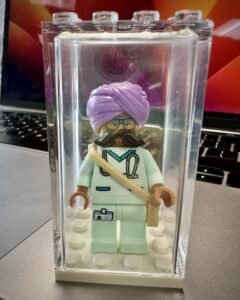It’s been a challenging winter health-wise, with multiple eye surgeries and extremely poor vision. But family, friends and NHS professionals have helped me find enough fortitude to reach the other side.
St Andrew’s Day
(30 November 2022)

The same day my Sight Scotland charity fundraiser reached £1k, I also found out that the retina in my left, “good eye”, had detached. With dramatic irony, timing is everything.
I’d been struggling with my eyesight for a few weeks in November, but presumed it was another small bleed. I was told to expect further haemorrhages going forward, so thought this was par for the course as someone living with diabetic retinopathy.
My sight loss journey (13 April 2021)
Retinal detachment
This retinal detachment presented itself very differently from those I’d previously experienced in the right eye. I didn’t have the same vibrant flashes or large dark shadow, the symptoms for this detachment were far more discrete. I was struggling to read small text, bumping into more objects than normal and having particular issues in low-light environments.
What is a detachment?
Technically a detached retina is when the thin layer at the back of your eye (retina) becomes loose. There are a number of reasons why people experience this serious condition, mine is caused by diabetic retinopathy (eye disease).
NHS advice on a retinal detachment
War of attrition
I’ve had T1D since 16 and it’s an aggressive chronic disease that some accurately describe as a ‘war of attrition’. Major surgery is the only viable option to prevent further sight loss.
Previous sight loss
In 2020 and 2021 I had five surgeries on my right eye to try and keep the retina attached. The final outcome was to leave a permanent standard silicone oil (SSO) in my right eye acting as a retinal tamponade. The SSO substantially blurs my vision, I‘ve become very dependent on the left for reading and other everyday tasks that demand good visual acuity.
Interactive – SSO compared to healthy vision
Surgeries #6 & #7
(8 & 28 December 2022)

My consultant was keen to act quickly, and I was fortunate to get an initial vitrectomy surgery scheduled in just over a week.
Vitrectomy is a surgery to remove some or all of the vitreous humour from the eye (the eye’s clear internal jelly) and a gas can be used to help hold the retina in place.
The first surgery created a substantial amount of interior bleeding, so much that my eyesight was still very poor after the gas bubble had started to dissolve. The second surgery successfully cleared the residual blood, but unfortunately required another lengthy round of positioning.
After both surgeries the visual acuity in my left eye was extremely poor. I couldn’t make out the number of fingers held up by my healthcare professional (HCP), only that her hand was near my face.
Completely failing to read any letters on a logMAR chart with either eye was a new low for me. It was hard to imagine things getting better, but I had to dig deep and hold on for the ride.
Uncertainties
This dramatic change in vision was challenging, as was the psychological impact of having to substantially rely on others for care and support. For me, the hardest part is the uncertainty of it all. Will this surgery work, can I continue in my job with these changes, how many more surgeries can I mentally cope with?
It’s easy for your mind to run away with itself, so I tried my best to focus on what I can practically do to give myself the best chance of recovery. And to be honest, following through with the required positioning was my primary objective.
What is positioning?

When you have gas or oil in your eye you may need to position 45 minutes out of every hour. This allows the bubble in your eye to float to the best position to support the retina.
The 15 mins out of the hour when you don’t position you can move around freely.
The optimum position will vary depending on your surgery, but it could be sitting upright, left or right cheek to pillow, or face-down. I drew the short straw.
Posturing face-down allows the bubble to press against the macula (centre of the retina). In order to achieve this, you should keep your face parallel to the floor.
Protracted recovery period
Family was crucial to my convalescence, with 75% of my time face-down and limited means to read I relied heavily on my mum. In total, I spent 17 days face-down over a 24-day period.
Finding joy

It’s paramount that you continue with your interests and hobbies, even if that requires some clever adaption. Mum would read ‘Blocks’ Lego magazines out loud to me whilst I positioned face down, describing fan built models and providing her valued opinion on them (she’s not overly impressed by Technic cars, just like moi) . We regularly build as a family, watch Lego Masters on TV and sort my inventory together. She’s a bona fide AFOl, but just doesn’t know it.
The only thing we really watched in December was Strictly. We had to watch the final in 15 mins spurts every hour, it took a whole day to find out the winner. Thankfully our favourite Hamza won, not a complete surprise given my mum’s devout voting history.
Giving thanks
I’m blessed to have the best friends to support me. Whether driving me to appointments, collecting prescriptions, sending me cheery messages, AI generated poems and thoughtful get-well gifts.

I’m so thankful for the amazing HCPs at my NHS hospital, their medical expertise and empathetic support have helped me get through both the diagnosis and surgeries.
One particular phrase my surgeon used early on still resonates with me, they assured me ‘we are on this (ophthalmic) journey together’. Knowing they were equally invested in a successful outcome gave me genuine solace.
In the pink
(24 January 2023)
Delighted to report I’m back at work now. I still take three different eye drops, a cataract surgery is required and there are some visual anomalies in my peripheral vision. But to be 100% honest these are minor annoyances, to have my retina attached again with pretty good vision is a perfect start to my year.
My guide to eye surgery
Lastly, I’ve written a short, practical guide to eye surgeries from a patient perspective. After seven procedures in the last three years (4 bubbles & 3 oils) I’ve picked up a few tips and tricks.
My hope is this advice will help you have a positive experience when attending hospital for any surgical appointment, not just ophthalmic procedures.
N.B. This guide is also an open-licensed educational resource that can be reused, remixed and shared. Please do comment or contact me with any feedback or questions.
Copyright and licence
The text, images and interactives published within this post are all intended to be shared, reused and remixed. In order to encourage this, I’ve applied a Creative Commons open licence to my own content where the only requirement is to include the following attribution.
Copyright © Stewart Lamb Cromar 2023 CC BY.
This work is licensed under a Creative Commons Attribution 4.0 International License.
Disclaimer
Please note this blog and its resources are a personal record of my own experiences. They have not been verified by any qualified medical professionals or other individuals from the University of Edinburgh.

Comments
One response to “Face Down, But Looking Up”
[…] December 2022 I underwent my 7th ophthalmic surgery (vitrectomy for a retinal detachment), the first was back in […]